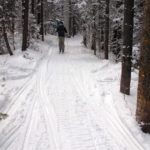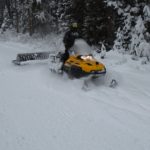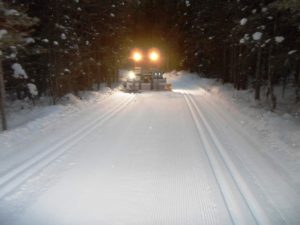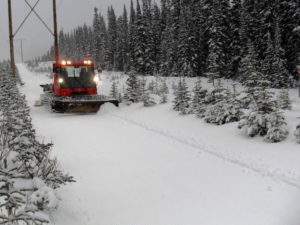Nov 22, 2020: For our new skiers, I’d like to explain the grooming process. When I started skiing, it seemed as if the tracksetting appeared like magic, and I had no idea what was involved. There is a lot more to it than I’m covering here, but in the interests of brevity I’ll keep it simple.
Grooming and tracksetting terms
Snowmobile packing: The snowmobiles start the grooming process by packing the snow with no implement attached. It leaves a rough and uneven surface with the imprint of the snowmobile’s track and ski runners. It can be difficult to ski on this because of the ridges and ruts. Depending on snow depth, hazards can be present such as rocks, dirt and tree roots. MaSid(see photo) is lucky to have wide skis for negotiating Boulton Creek which has been snowmobile packed. Click on the photo for a larger image. Sometimes the snowmobile will pull an implement for flat-packing the snow.
Rolling or Roll-Packing: The snowmobile pulls a roller to pack the snow and leave a corduroy surface. If snow cover is thin, there can still be hazards present such as rocks, dirt, tree roots, and uneven surfaces. A good example of a rolled but still unskiable trail was yesterday when I attempted to ski down Packers. Skiing uphill is relatively safe because you’re going slow, but downhill would be suicidal. I was lucky to have encountered two groups of uphill skiers just as I started out.
Grooming is a catch-all term which can describe the entire process of working the snow to make it better for skiing. On here, it usually means the machines have left a corduroy surface.
Tracksetting: Setting tracks is normally the final step in the whole process of trail grooming and can be accomplished with a snowmobile pulling an implement or a snowcat. Depending on the temperature, the snow characteristics, or previous grooming, the tracks can be very soft for a few hours after tracksetting. A snowcat will generally make a firmer track than an implement pulled by a snowmobile.
Starting from scratch on unpacked snow, the grooming process from start to finish can require three or four passes with the snowcat. On Thursday night, when James was working on Elk Pass, it would have required four passes to complete the process.
The grooming process can be done by snowmobiles or snowcats. Did you see my photo of the PLPP snowcat “pulling” snow onto the trail by blading on Hydroline? Snowmobile grooming isn’t able to do this.
As the grooming personnel start the process, they often encounter fallen trees which require clearing. Many times they will stop to shovel snow from the side of the trail onto thin spots. Think of all the picnic tables in PLPP where the snowcat operator has to groom underneath without leaving any footprints in the snow Picnic Table Mystery Solved.
The number of controls and settings in a snowcat’s cab would befuddle anyone who’s inexperienced. The operator has a myriad of things to watch for and adjust accordingly. What variables do you think the operator takes into consideration when adjusting the controls for the best results?








Based on the above, we can see that grooming is expensive, especially to achieve the high quality Pisten Bully grooming. On Friday, we skied with a group of friends on the marvellous fresh grooming on the Elk Pass and Blueberry trails. Everyone had a great time and most certainly enjoyed the grooming.
PLPP is the closest location to Calgary with a reliable snow pack for a long ski season.
In the past years, there was no charge for this grooming at PLPP and this year there is a very modest charge for parking. There is no reason why the users should not cover the grooming costs.
Many users would be happy to pay for more frequent grooming with examples such as at the Golden Nordic Club (Adult $12/day 35 km of trails), the Sovereign Lake club (at Vernon Adult $19/day 50 km of trails), Canmore Nordic Centre (Adult $15/day 65 km of trails) and others. Note that Golden grooms about half of the trails daily and Sovereign grooms all of the trails daily.
At PLPP we have witnessed MANY happy skiers so far this year. This large group of skiers should be able to fund more regular grooming of more trails daily at PLPP, especially this winter of high demand for ski trails.
Thanks to the groomers, Nordiq Canada and the volunteers who helped to retain grooming at PLPP. We are indeed fortunate to have these trails groomed this winter.
Also a shout out to the excellent work done by the volunteers at West Bragg! They are also seeking a bit more funding for their proposed new smaller Pisten Bully equivalent (Sno Rabbit). We should all help with their funding as well.
Perhaps I should have offered some wax….
Several facts: 1) A small portion of PLPP contains the only high quality classic ski grooming (Pisten Bully) in South Western Alberta.
2) There are very small signs at the start of the trails in PLPP stating that skating is not allowed since it damages the classic track. The tracks are too close together to provide room for skating.
3) Many people are not aware that skating is not allowed in PLPP, but will copy other people that skate, since it is of low probability that they have read the small signs.
4) One person skated over much of the groomed classic track up Whiskey Jack.
5) One person was skating on Tyrwhitt. There were no groomed classic tracks on Tyrwhitt.
6) Yes, I was irritated.
Note that the only trails currently available in this area for skating are at Lake Louise (MLR and GDT) and Frozen Thunder.
Perhaps Brews did not remember that he skated much of the way up Whiskey Jack as wel as skating on Trywhitt
Perhaps I should have offered some wax. Note that Whiskey Jack was trackset. My main purpose in discouraging skating on any trail in PLPP was to ensure that people are aware that skating is not appropriate on the narrow trails in PLPP, since there is not enough width between the classic tracks. Signs posted at the start of all trails state that skating is not permitted. When others see the skating tracks, they assume that skating is permitted. Note that the only trails currently available for skating are at Lake Louise (MLR and GDT) and Frozen Thunder.
Appreciate the informative article.If a trail is packed and not track set eg Tyrwhitt this weekend , what is the etiquette regarding skating ?
I found it difficult in places to maintain glide & was switching between classic diagonal and skating . A gentleman stopped to tell me it was extremely rude to skate on a classic trail . I don’t see the issue on an uncrowded trail with no set tracks to damage but willing to consider other viewpoints
The main issue is if your skating stride cuts into the trackset, because it damages the trackset and makes it less smooth for classic skiers. Not a problem if there’s no machine or skier trackset, but still a problem if you’re damaging a good skier-made track. Skating takes up more of the trail width than classic, so you need to shorten your stride when necessary to allow other skiers to pass. As far as I’m concerned, even with machine trackset, skating isn’t a problem if you can manage to stay on just the packed section of the trail, although it probably means there just isn’t enough room for skating unless the trail is really wide. And it’s not only skaters that can damage trackset. I often encounter classic skiers with poor grip damaging trackset on uphill sections, by herringboning up the track instead of next to it.
That was no ‘gentleman’. I skied Tyrwhitt this afternoon &, for most of it, a conscientious ‘skater’ would have not been detrimental to the trail at all. An easy comparable would be Fat bikers on a multi-use trail where they are causing NO harm to the trackset. Blanket statements like his are unrealistic & likely come from a place of misguided entitlement. Or perhaps he was just a curmudgeon. As Bob noted recently, there ARE no skate ski trails in PLPP but a few strides that don’t negatively affect any trackset (machine OR skier-set) should go without mention.
Just my opinion but I have worked as a groomer for ~ a thousand hours; skate & ‘primarily’ classic; …& definitely worship a good trackset
Kind if interesting to note that the whole skating technique was born from classic skiers using an alternative technique to bridge the gap during some tedious sections or challenging terrain when it was simply more efficient (faster) to skate.
More than appropriate to throw a few skate strides in when it’s safe etc.
Just shows you have a diverse skillset and you should make use of it. No harm, No foul.
Hi Bob, we skied down Packers on Saturday not realizing the condition it was in, happy to report we survived! But yes, it was very dicey. It was a veritable roller coaster. Great day nonetheless!
Easiest way to look at grooming is to think of it like making a snowball. What is required when the snow is cold and dry? What happens if you make a snowball when the snow is wet and it freezes?
The answers to these questions is the basic principle of all grooming.
I concur with Mike W. This article is most useful and should make a lot of people think about the crew and all they do for us ( I know it certainly made me appreciate even more what is done for us). This article is good for both new comers to our sport but as well to people like myself who have been using the area for many, many, years. Thank you Bob.
I would also like to pass on a huge thank you to all the folks who sent in emails etc. to the government. Without the pressure we put on Jason Nixon and others and without Nordiq Alberta the wonderful service described here would not have happened.
Hey Bob,
Totally agree this was a great example of what some letter writing ( Okay, a lot of letter writing) and expression of concern can do. This is just a finer point but when we say we “pressured” Jason, I would like to think that it was more accurate to say that we gave him the ammunition he needed to make this happen. When we say we pressured him it feels like we are saying he was resistant to it and we only got this through force.
He, as well as the others involved, seemed genuinely excited and pleased to be part of the solution. I would say this was a big win for him as well. I had no involvement other than a couple emphatic emails but I would assume there were a lot of late nights and long meetings to get this done and just hate to see that we paint him with a negative brush when he was ultimately the conduit to making this happen.
Credit where credit is due (and all that).
Nice to see that getting involved does actually get results!
An excellent article, Bob! How about listing it under Resources, so it’s readily accessible into the future?
Good idea, done! -Bob